2017 年广东暨南大学基础英语考研真题
学科、专业名称:日语语言文学
研究方向:
考试科目名称:241 基础英语
考生注意:所有答案必须写在答题纸(卷)上,写在本试题上一律不给分。
Part I
Cloze (10 points)
Directions: Thereare20blanksinthefollowingpassage.Foreachblankthereare
four choices marked A, B, C and D. You should choose the ONE that best fits into
thepassage. Thenmarkthe corresponding letter on the AnswerSheet with a single
line through the center.
You hear it all along the river. You hear it, loud and strong, from the rower as
they urge the junk ____1____ its high stem, the mast lashed alongside, down the
____2____ running stream. You hear it from the trackers, a more breathless chant,
as they pull ____3____ against the current, half a dozen of them perhaps if they
are ____4____ a boat, a couple of hundred ____5____ they are hauling a splendid
junk, its square sail set, over a rapid. On the junk a man stands amidships beating
a drum ____6____ to guide their efforts, and ____7____pull with all their strength,
like men possessed, bent double; and sometimes in the ____8____ of their travail
they crawl ____9____, on all fours, like the beasts of the field. They strain, strain
fiercely, ____10____ the pitiless might of the stream. The leader goes ____11____
the line and when he sees one who is not putting all his ____12____ into the task
he brings down his split bamboo ____13____ the naked back. Each one must ____14____
or the labor of all is ____15____. And still they sing a vehement, eager chant, the
chant of the ____16____ waters. I do not know how words can describe what there is
in it of effort. It ____17____ to express the straining heart, the breaking muscles,
and ____18____ the indomitable spirit of man which overcomes the ____19____ force
of nature. Though the rope may part and the great junk swing back, ____20____ the
rapid will be passed; and at the close of the weary day there is the hearty meal…
�
1. A. on
B. in
C. with
D. by
2. A. slow
B. shifting
C. swift
D. strengthen
3. A. hardly
B. desperately
C. exactly
D. quickly
4. A. taking up
B. making
C. sitting in
D. shouldering
5. A. when
B. if
C. as
D. although
6. A. incessantly
B. increasingly
C. indefinitely
D. inwardly
7.
A. everyone
B. they
C. he
D. themselves
8.
A. extreme
B. extremes
C. extremity
D. extremely
9. A. on the ground
B. all over the field
C. in the front
D. by the
side
10. A. at
11. A. against
B. in
B. to
C. towards
D. against
C. near and far
D. up and down
12. A. capacity
B. will
C. ability
D. courage
13. A. in
B. at
C. on
D. up
14. A. do his part
B. do his share
C. do his utmost
D. try hard
15. A. vain
B. necessary
C. exciting
D.
disappointing
16. A. disturbed
B. quiet
C. turbulent
D. quick
17. A. deserves
B. serves
C. works
D. does
18. A. on the other hand
B. at the same time
C. as well as
D. after
all
19. A. pitiless
B. pitiful
C. generous
D. mean
20. A. the ends
B. on end
C. in the end
D. at the end
Part II
Reading Comprehension
Section A (40 points)
Directions:Thereare4passagesinthissection.Eachpassageisfollowedbysome
questionsorunfinishedstatements.Foreachofthemtherearefourchoicesmarked
A,B,CandD.Youshoulddecideonthebestchoiceandwritethecorrespondingletter
�
on the Answer Sheet.
Questions 21 to 25 are based on the following passage.
For some time past it has been widely accepted that babies – and other creatures
– learn to do things because certain acts lead to “rewards”, and there is no reason
to doubt that this is true. But it used also to be widely believed that effective
rewards, at least in the early stages, had to be directly related to such basic
physiological “drives” as thirst or hunger. In other words, a baby would learn
if he got food or drink or some sort of physical comfort, not otherwise. It is now
clear that this is not so. Babies will learn to behave in ways that produce results
in the world with no reward except the successful outcome.
Papousek began his studies by using milk in the normal way to “reward” the
babies and so taught them to carry out some simple movements, such as turning the
head to one side or the other. Then he noticed that a baby who had had enough to
drink would refuse the milk but would still go on making the learned responses with
clear signs of pleasure. So he began to study the children’s responses in situations
where no milk was provided. He quickly found that children as young as four months
would learn to turn their heads to right or left if the movement “switched on”
a display of lights – and indeed that they were capable of learning quite complex
turns to bring about this result, for instance, two left or two right, or even to
make as many as three turns to one side.
Papousek’s light display was placed directly in front of the babies and he made
the interesting observation that sometimes they would not turn back to watch the
lights closely although they would “smile and bubble” when the display came on.
Papousek concluded that it was not primarily the sight of the lights which pleased
them, it was the success they were achieving in solving the problem, in mastering
the skill, and that there exists a fundamental human urge to make sense of the world
and bring it under intentional control.
21. According to the author, babies learn to do things which ________.
�
A) are directly related to pleasure
B) will meet their physical needs
C) will bring them a feeling of success
D) will satisfy their curiosity
22. Papousek notice in his studies that a baby __________.
A) would make learned responses when it saw the milk
B) would carry out learned movements when it had enough to drink
C) would continue the simple movements without being given milk
D) would turn its head to right or left when it had enough to drink
23. In Papousek’s experiment babies make learned movements of the head in order
to __.
A) have the lights turned on
B) be rewarded with milk
C) please their parents
D) get praise from the adults
24. The babies would “smile and bubble” at the lights because ____________.
A) the lights were directly related to some basic “drives”
B) the sight of lights was interesting
C) they need not turn back to watch the lights
D) they succeeded in “switching on” the lights
25. According to Papousek’ s experiment, the pleasure babies get in achieving
something is a reflection of _______________.
A) a basic human desire to understand and control the world
B) the satisfaction of certain physiological needs
C) their strong desire to solve complex problem
D) a fundamental human urge to display their learned skills
Questions 26 to 30 are based on the following passage.
�
Believe it or not, optical illusion(错觉) can cut highway crashes.
Japan is a case in point. It has reduced automobile crashes on some roads by
nearly 75 percent using a simple optical illusion. Bent stripes, called chevrons(人
字形), painted on the roads make drivers think that they are driving faster than
they really are, and thus drivers slow down.
Now the American Automobile Association Foundation for Traffic Safety in
Washington D.C. is planning to repeat Japan’s success. Starting next year, the
foundation will paint chevrons and other patterns of stripes on selected roads around
the country to test how well the patterns reduce highway crashes.
Excessive speed plays a major role in as much as one fifth of all fatal traffic
accidents, according to the foundation. To help reduce those accidents, the
foundation will conduct its tests in areas where speed-related hazards are the
greatest — curves, exit slopes, traffic circles, and bridges.
Some studies suggest that straight, horizontal bars painted across roads can
initially cut the average speed of drivers in half. However, traffic often returns
to full speed within months as drivers become used to seeing the painted bars.
Chevrons, scientists say, not only give drivers the impression that they are
driving faster than they really are, but also make a lane appear to be narrower.
The result is a longer lasting reduction in highway speed and the number of traffic
accidents.
26. The passage mainly discusses _______________.
A) a new way of highway speed control
B) a new pattern for painting highways
C) a new approach to training drivers
D) a new type of optical illusion
27. On roads painted with chevrons, drivers tend to feel that __________.
A) they should avoid speed-related hazards
B) they are driving in the wrong lane
�
C) they should slow down their speed
D) they are approaching the speed limit
28. The advantage of chevrons over straight, horizontal bars is that the former
_____.
A) can keep drivers awake
B) can cut road accidents in half
C) will have a longer effect on drivers
D) will look more attractive
29. The American Automobile Association Foundation for Traffic Safety plans to __.
A) try out the Japanese method in certain areas
B) change the road signs across the country
C) replace straight, horizontal bars with chevrons
D) repeat the Japanese road patterns
30. What does the author say about straight, horizontal bars painted across roads?
A) They are falling out of use in the United States.
B) They tend to be ignored by drivers in a short period of time.
C) They are applicable only on broad roads.
D) They cannot be applied successfully to traffic circles.
Questions 31 to 35 are based on the following passage.
Is a car that does not have to be refueled every few hundred miles, with the
atom exploding peacefully beneath the bonnet, possible in the future? In theory it
is, since already the atom has been harnessed to drive submarines, and an atomic
engine is already in existence. But there are many problems still to be conquered
before such an engine can in fact be fixed into a car.
Now what exactly are these problems that stand between you and the car? Frankly,
most of them can be summed up in one word ---- radiation. An atomic reactor, the
�
kind of engine that would produce energy by atom-splitting, throws off radiation,
extremely dangerous radiation. These rays are just as dangerous as when they are
released from an atomic bomb. This radiation penetrates anything except the thickest
concrete and lead, with fatal results for anybody in its path. Thus, at the moment,
any car carrying an atomic engine would also have to carry many tons of lead in order
to prevent the radiation from escaping.
Since a car made up of tons of lead is rather impracticable, the only answer
at the moment seems to be the discovery or invention of a metal that will be strong
enough to hold in the rays, but at the same time light enough for a vehicle to carry,
with ease and economy. Most likely this metal would have to be synthetic, since no
natural metal except lead has yet proved fit for the job. When this light metal is
invented, the motoring world will be well on the way to an atomic car. However, even
after the invention of a protective but light metal, two other problems still remain,
those of economics and safety.
But then the problem of safety still remains. Suppose that there is a road
accident involving one, or perhaps two, atomic cars, and that the atomic reactor
or its protective covering were damaged. Any explosion would be equal to that of
a very small atomic bomb. The effects of such an explosion would be felt for several
miles around. As will be realized, this is perhaps the biggest problem of all to
overcome.
31. According to the passage an atomic car is _______.
A) only science-fiction
B) theoretically possible
C) only a matter of time
D) nothing but a dream
32. One of the biggest problems in manufacturing an atomic car is __________.
A) its high cost
B) the size of the atomic engine
�
C) protection against radiation
D) the weight of the atomic engine
33. The motoring world will be well on the way to an atomic car once we have _____.
A) a cheap synthetic metal
B) a light strong metal
C) a strong synthetic metal
D) a protective but light metal
34. Another important issue for atomic cars is ___________.
A) the quality of manufacturing technology
B) the practicability of mass production
C) the lifetime of such cars
D) the danger of an atomic explosion resulting from a traffic accident
35. The author’s attitude towards atomic cars is ________.
A) doubtful
C) negative
B) favorable
D) neutral
Questions 36 to 40 are based on the following passage.
As the horizons of science have expanded, two main groups of scientists have
emerged. One is the pure scientist; the other, the applied scientist.
The pure or theoretical scientist does original research in order to understand
the basic laws of nature that govern our world. The applied scientist adapts this
knowledge to practical problems. Neither is more important than the other, however,
for the two groups are very much related.
Sometimes the applied scientist finds the “problems” for the theoretical
scientist to work on. Let’s take a particular problem of the aircraft industry:
heat-resistant metals. Many of the metals and alloys that perform satisfactorily
�
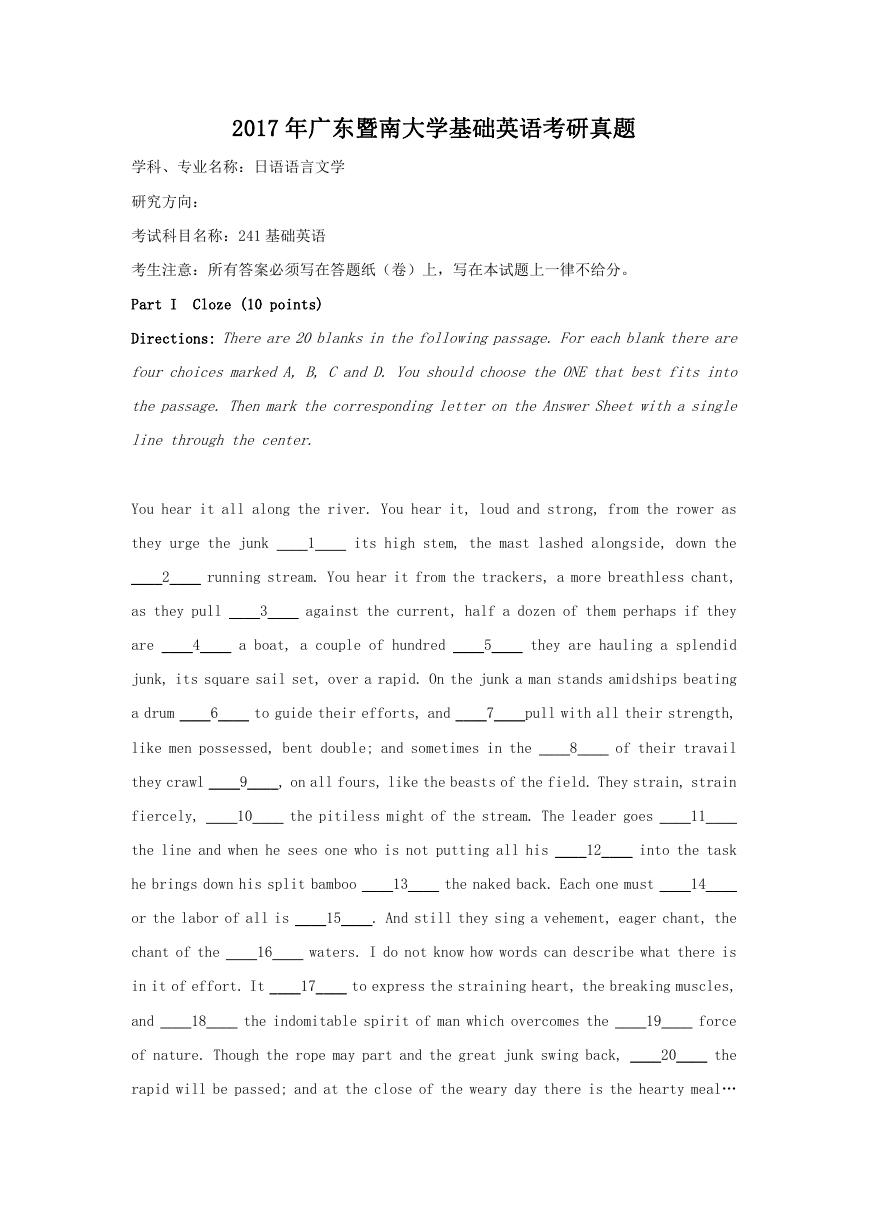
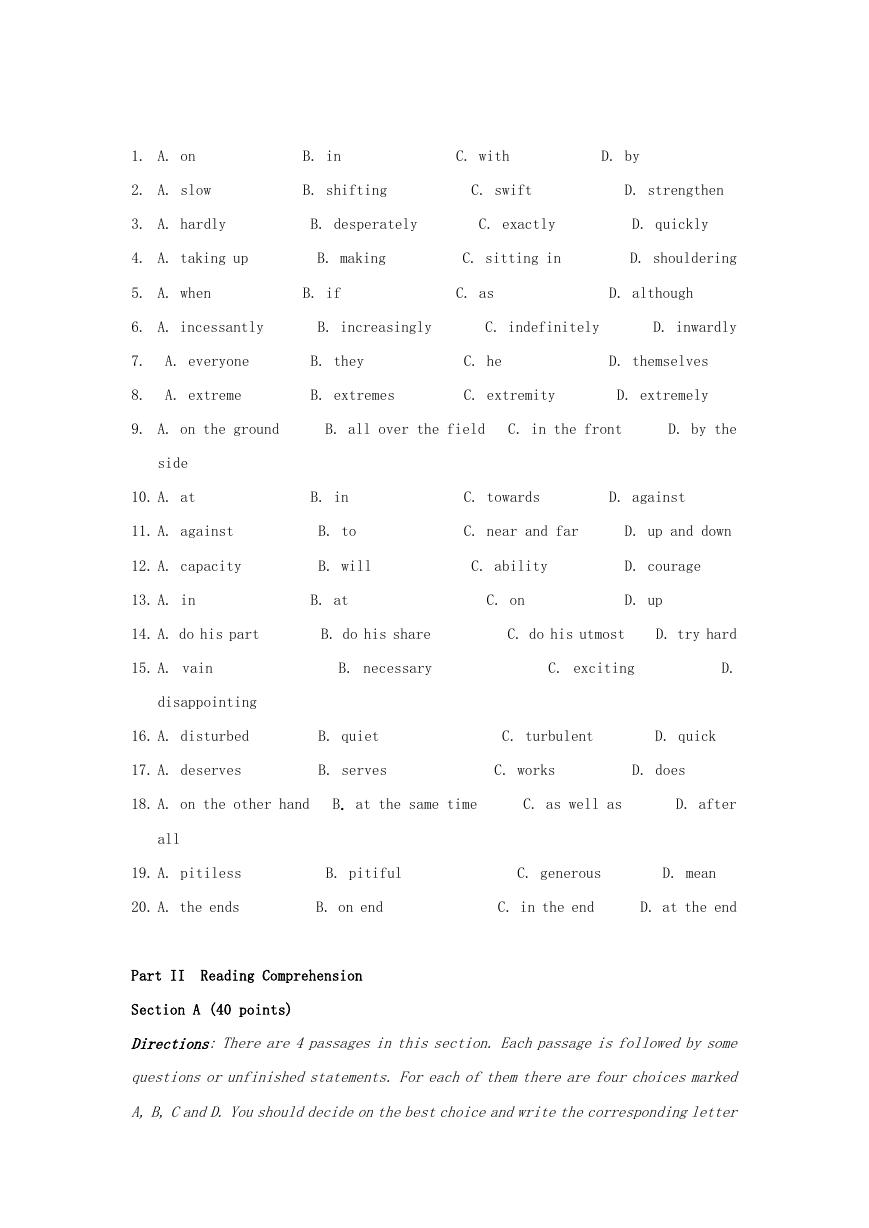

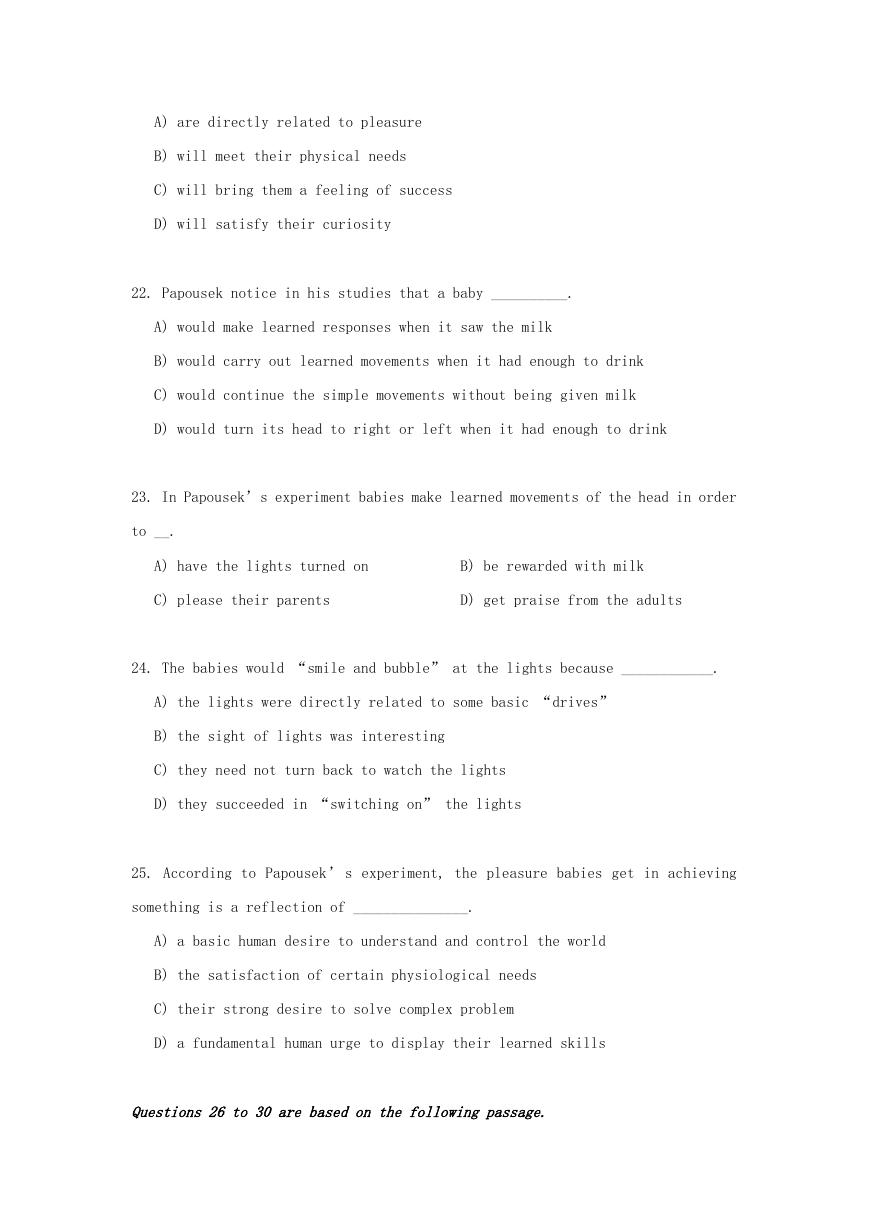
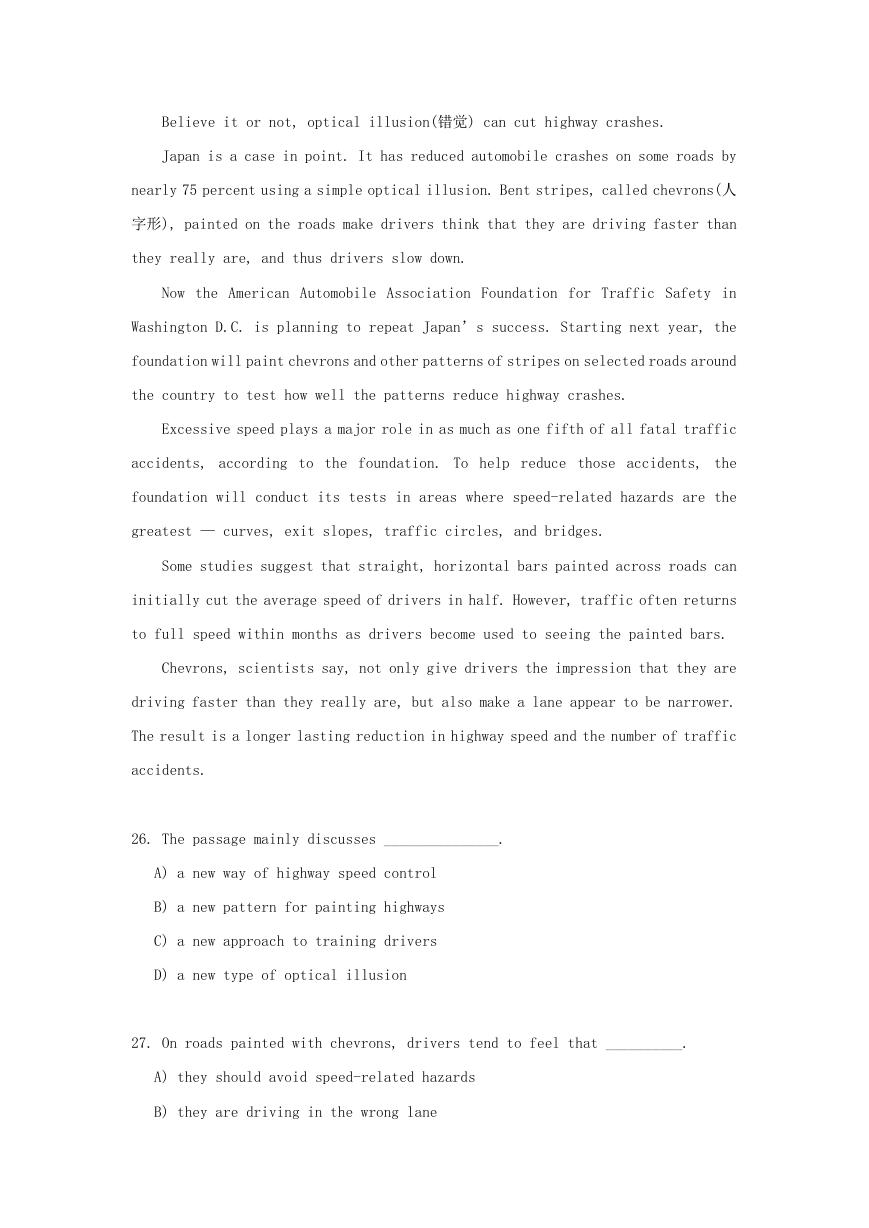
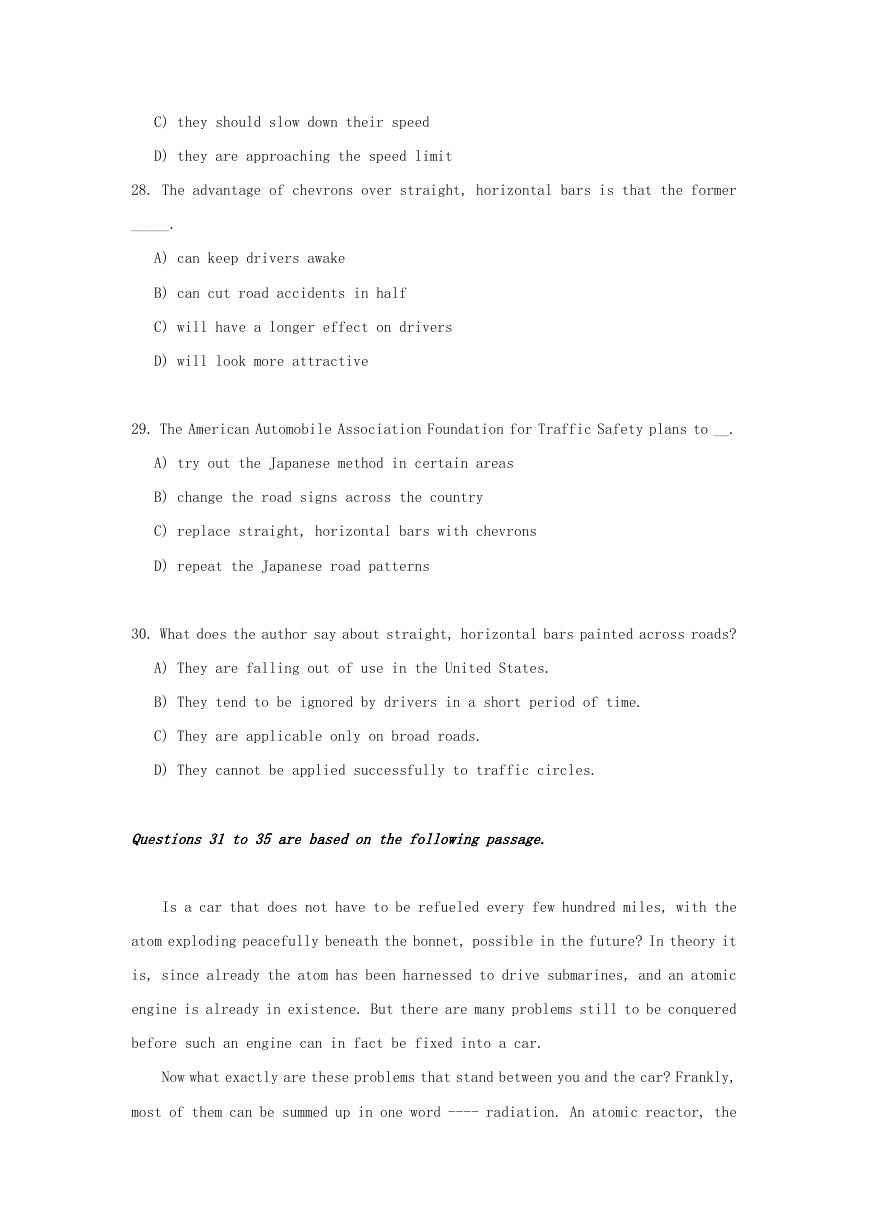
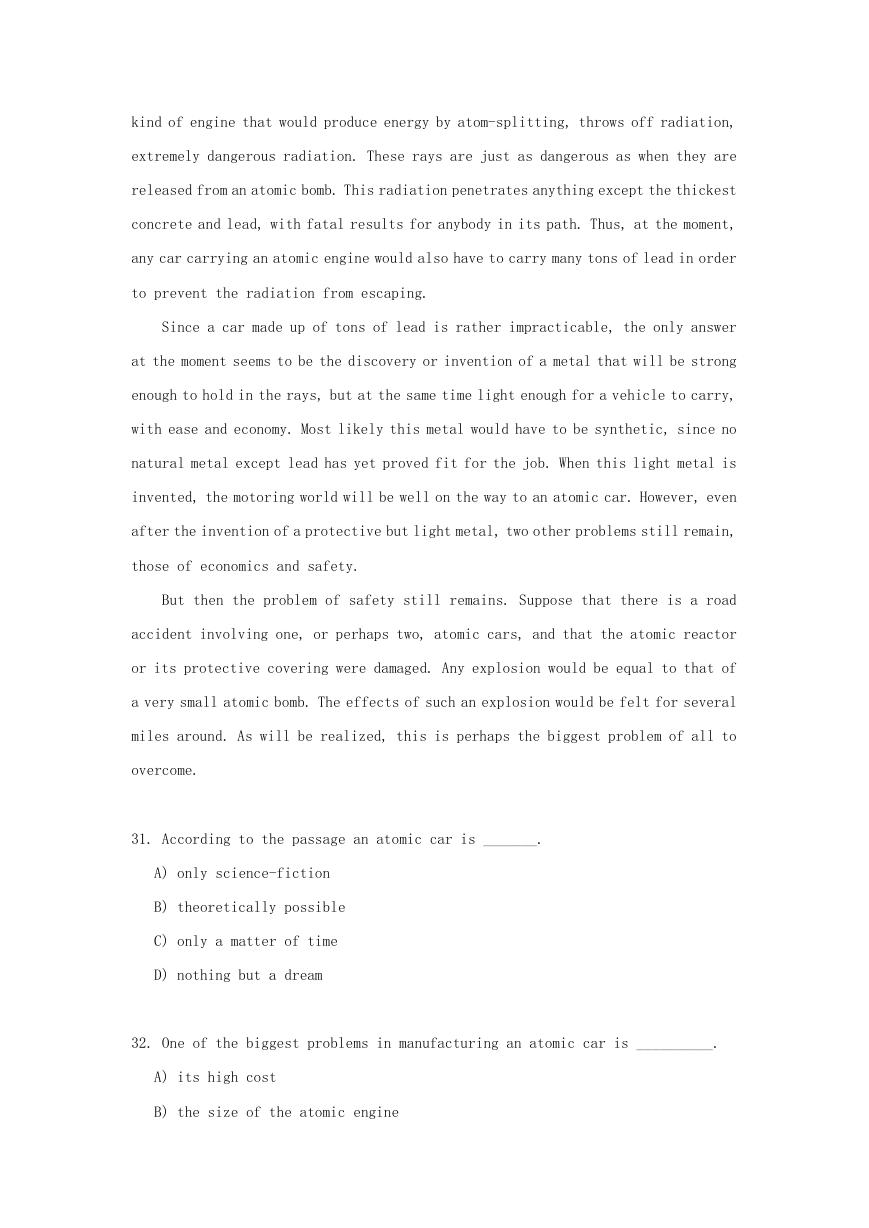
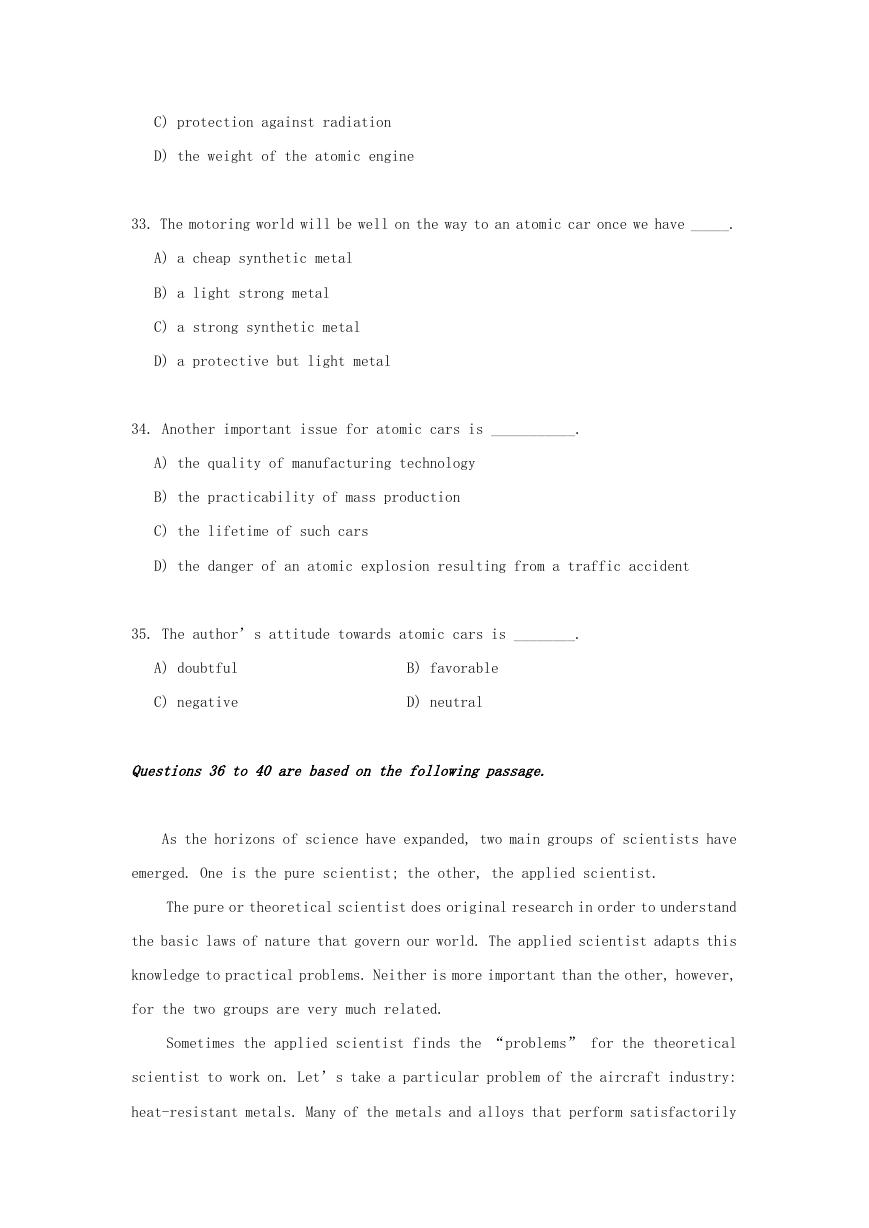








 2023年江西萍乡中考道德与法治真题及答案.doc
2023年江西萍乡中考道德与法治真题及答案.doc 2012年重庆南川中考生物真题及答案.doc
2012年重庆南川中考生物真题及答案.doc 2013年江西师范大学地理学综合及文艺理论基础考研真题.doc
2013年江西师范大学地理学综合及文艺理论基础考研真题.doc 2020年四川甘孜小升初语文真题及答案I卷.doc
2020年四川甘孜小升初语文真题及答案I卷.doc 2020年注册岩土工程师专业基础考试真题及答案.doc
2020年注册岩土工程师专业基础考试真题及答案.doc 2023-2024学年福建省厦门市九年级上学期数学月考试题及答案.doc
2023-2024学年福建省厦门市九年级上学期数学月考试题及答案.doc 2021-2022学年辽宁省沈阳市大东区九年级上学期语文期末试题及答案.doc
2021-2022学年辽宁省沈阳市大东区九年级上学期语文期末试题及答案.doc 2022-2023学年北京东城区初三第一学期物理期末试卷及答案.doc
2022-2023学年北京东城区初三第一学期物理期末试卷及答案.doc 2018上半年江西教师资格初中地理学科知识与教学能力真题及答案.doc
2018上半年江西教师资格初中地理学科知识与教学能力真题及答案.doc 2012年河北国家公务员申论考试真题及答案-省级.doc
2012年河北国家公务员申论考试真题及答案-省级.doc 2020-2021学年江苏省扬州市江都区邵樊片九年级上学期数学第一次质量检测试题及答案.doc
2020-2021学年江苏省扬州市江都区邵樊片九年级上学期数学第一次质量检测试题及答案.doc 2022下半年黑龙江教师资格证中学综合素质真题及答案.doc
2022下半年黑龙江教师资格证中学综合素质真题及答案.doc